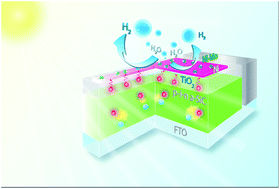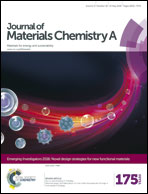Engineering the kinetics and interfacial energetics of Ni/Ni–Mo catalyzed amorphous silicon carbide photocathodes in alkaline media†
Abstract
Photoelectrochemical (PEC) water splitting is a sustainable approach to produce a renewable fuel by harvesting the energy of the Sun to split water to form hydrogen and oxygen. In order to drive the water splitting reaction efficiently, substantial ohmic losses due to poor ionic conductivity of the electrolyte should be avoided, and therefore the reaction should be carried out at an extreme electrolyte pH. Herein we demonstrate the photoelectrochemical activity of an amorphous silicon carbide (a-SiC) photocathode for solar hydrogen evolution using an ultrathin nickel (Ni) film coupled with a nickel molybdenum catalyst (Ni–Mo) in a highly alkaline solution (pH 14). The incorporation of the Ni film coupled with Ni–Mo nanoparticles increases the number of active sites and therefore improves the kinetics of the hydrogen evolution reaction. Additionally, we report the influence of the catalyst configurations on the ohmic and solid liquid junction behavior on semiconducting interfacial layers. The a-SiC photocathode coated with the Ni/Ni–Mo dual-catalyst produces a photocurrent density of −14 mA cm−2 at 0 V vs. RHE using only cheap and abundant materials. This photocurrent is the highest recorded value from an amorphous-Si-based photocathode, and is achieved with a total film thickness of less than 150 nm.

- This article is part of the themed collection: Emerging Investigators 2016: Novel design strategies for new functional materials

 Please wait while we load your content...
Please wait while we load your content...